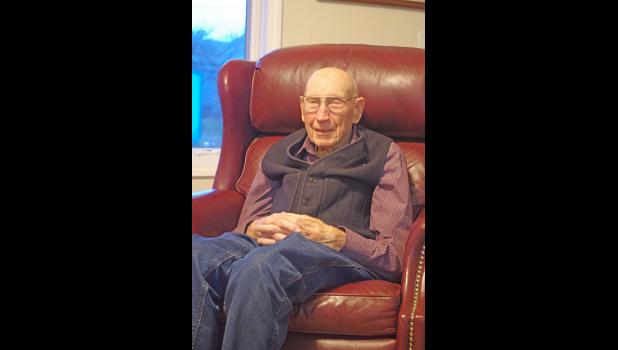A man of the land, Emerson reflects on 95 years of life in Haakon County
Wed, 12/06/2017 - 11:35am
admin
Part 1 in a 2 part series
By:
Nancy Haigh
Ninety-five years of living has provided Philip resident Keith Emerson with a passel of friends, family and wonderful memories.
Many know Keith through Haakon County Abstract, a business he owned for nearly 20 years. Through that business, Keith learned a lot about the land in the county as well as current and former residents.
Keith said he has always enjoyed history, and researching land parcel titles brought the county to life for him.
Keith arrived in 1922, without the aid of a doctor, at his folks’ ranch 32 miles northwest of Philip.
His parents, Roy and Gertrude, were early day homesteaders. Roy came to the area in 1907 to the land where Keith was born. Gertrude was born in Madison, Dakota Territory. When she and Roy married, she had been living up near the North Dakota border. Hereford cattle grazed the lush prairie grasses. Very little was done in the way of farming, noted Keith; there were some row crops and hay to help winter the cattle.
Keith was their second son, and only living child. Gertrude was a school teacher and homeschooled Keith his first three years. Times were lean in the late 1920s when Gertrude won the election and became Haakon County’s register of deeds.
To town they moved, leaving Roy to run the ranch. Keith recalled he then attended school in the 1928 brick building at the top of the hill. The structure was a newer facility that housed overflow from the school built in 1914. His teacher was Catherine Griffith, who later became Haakon County superintendent of schools.
Unfortunately, Gertrude lost the following election and they returned to the ranch. Gertrude returned to teaching, first at the Ferguson-O’Neill School.
It wasn’t long before Keith returned to school in Philip, this time as a high school freshman. When asked if he participated in sports, he gave a gentle laugh, and said he was too small, especially for football. He joked that he always wanted to make the 5’11” mark, but he couldn’t quite get there. He became active in other areas though, such as journalism.
After graduating in 1939, he headed east to Brookings to try his hand at agricultural engineering classes at South Dakota State College.
That, he said, did not go well. The classes and he didn’t get along very well. Little did he know at the time, it was going to cause more problems.
Keith stated all freshmen males had to enroll in Reserve Officer Training Corps (ROTC) for one year. “Our government must have known we would be going to war,” said Keith of the requirement.
Keith enlisted in the U.S. Navy in 1943. That’s when his declared major caused more problems. “They misinterpreted that. All they heard was engineering,” he said. They sent him to engineering school. “I struggled,” he admitted. The Navy tested him to see what he would be compatible with, turned out it was mathematics, but not to the engineering level. He was stationed at Ft. Lauderdale, Fla., where he graduated as a fire (gun) control operator.
He was assigned to the J. William Ditter, a newly minted destroyer which was launched July 4, 1944 and commissioned Oct. 28, 1944. The 2,200 ton ship was comprised of some of the top naval officers, said Keith. He said they were pulled from other ships in the naval fleet.
The ship left Florida, Keith recalled, and headed to the Atlantic Ocean for training exercises. After two or three weeks they left Norfolk, Va., sailed down to the Panama Canal, and into the Pacific Ocean. Just under a month later they docked at Pearl Harbor. About three weeks later they headed deeper into the Pacific – in time to participate in the Battle of Okinawa.
The battle began April 1, 1945. It was the final push toward Japan and the last major battle of World War II.
Keith remembered it was there that the ship was struck by two kamikazes. One blew a hole in the boat right above the water line. “It had two, 500 pound bombs on it,” said Keith. The day was June 6, 1945, and the ship was less than a year old. Keith related that the strikes left the boat without power. It was towed into port where it received temporary repairs to get it back to the United States.
Keith proudly said they were credited with shooting down 13 Japanese planes during the battle. The planes were targeting boats during the engagement.
Keith noted it was a very slow trip back to the United States. They were under half power and at a 45 degree list to port (left) side.
(continued next week)

